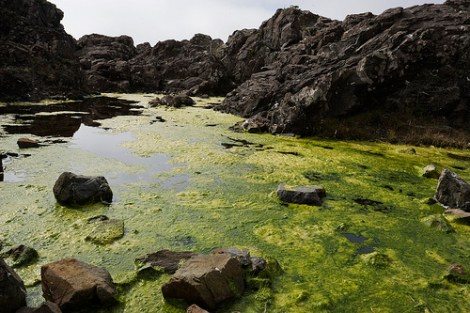
Grant HutchinsonAn algae bloom not created by a mad scientist.
Five years ago, Grist wrote about a man named Russ George, the head of an organization called Planktos. Planktos’ big idea for combatting global warming: You dump some iron into the ocean, it creates a massive algae (phytoplankton) bloom, then the algae absorbs carbon dioxide through the process of photosynthesis.
Here are some words Grist and our contributors used to describe the idea in 2007: risky, thin soup, possibly reckless. After all, algae dies. And dead things emit methane, which is worse for the atmosphere than carbon dioxide. Given the obvious risk of experimenting with dumping chemicals into the ocean in a half-baked effort at geoengineering — and given that George’s plan was to sell the blooms as carbon offsets — we were unenthusiastic about George’s proposed experiment, which, at the time, was focused on the Galapagos.
That experiment never happened. Instead, George recently dumped 100 tons of iron sulphate into the Pacific near Canada.
Lawyers, environmentalists and civil society groups are calling it a “blatant violation” of two international moratoria and the news is likely to spark outrage at a United Nations environmental summit taking place in India this week.
Satellite images appear to confirm the claim by Californian Russ George that the iron has spawned an artificial plankton bloom as large as 10,000 square kilometres. The intention is for the plankton to absorb carbon dioxide and then sink to the ocean bed — a geoengineering technique known as ocean fertilisation that he hopes will net lucrative carbon credits.
George is the former chief executive of Planktos Inc, whose previous failed efforts to conduct large-scale commercial dumps near the Galapagos and Canary Islands led to his vessels being barred from ports by the Spanish and Ecuadorean governments. The US Environmental Protection Agency warned him that flying a US flag for his Galapagos project would violate US laws, and his activities are credited in part to the passing of international moratoria at the United Nations limiting ocean fertilisation experiments
In case you thought that wasn’t sufficiently sketchy, here you go:
George says his team of unidentified scientists has been monitoring the results of the biggest ever geoengineering experiment with equipment loaned from US agencies like Nasa and the National Ocean and Atmospheric Administration. He told the Guardian that it is the “most substantial ocean restoration project in history,” and has collected a “greater density and depth of scientific data than ever before”. …
The dump took place from a fishing boat in an eddy 200 nautical miles west of the islands of Haida Gwaii, one of the world’s most celebrated, diverse ecosystems, where George convinced the local council of an indigenous village to establish the Haida Salmon Restoration Corporation to channel more than $1m of its own funds into the project.
The president of the Haida nation, Guujaaw, said the village was told the dump would environmentally benefit the ocean, which is crucial to their livelihood and culture.
“The village people voted to support what they were told was a ‘salmon enhancement project’ and would not have agreed if they had been told of any potential negative effects or that it was in breach of an international convention,” Guujaaw said.
Don’t worry, Guujaaw. I’m sure George’s unidentified scientists will prove how good the huge algae die-off is for salmon.
The moral of the story: If you have a scheme that you think can save the planet, try to get scientific and legal consensus on it before putting it into action.
The other moral of the story: Grist is five years ahead of the curve in spotting hustlers.



